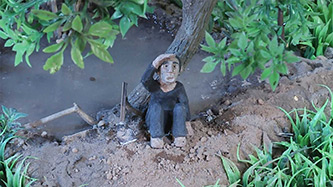Dear Sarith Mang, Sculptor,
I don't think I've ever met a film fan who doesn't get nostalgic over claymation. For many born prior to the 1990s, it gave their childhood memories weight and warmth. I assume this is why director Rithy Panh chose you to be the star of The Missing Picture. Or maybe - and more likely - your clay figurines were the only way he could stomach recreating the horrors he endured at the hands of the Khmer Rouge.
Before you correct me, I realize this film is not exactly "claymation," but rather a unique filmmaking approach that uses archival footage and tableau designs of your clay figurines-- sometimes combining both to create a sense of motion. For the most part, however, Pahn is trying to recreate still images: moments from his life that are burned into his memory but have been erased from all physical records. The scale of suffering is so grand that only by miniaturizing everything can he process what happened.
This is why all the flaws in your clay men, women, and children are so essential. The divots in their faces give life to their frozen expressions. The hard edges and chipped corners are suggestive of the suffering they endured as they withered away from starvation and torture. Even the crude paint simulates the decay of their work camp uniforms and the erosion of their souls. Your work is beautiful, haunting, and more human than anything that happened in Cambodia between 1975 and 1979.
Of course, it wasn't always so dire. Your work shines with colourful details as you recreate Panh's childhood, when he roamed busy streets and snuck onto big bright film sets. The contrast between this and the hell-on-earth conditions imposed by Pol Pot's communist regime are staggering, even in your molds. Pot was trying to create the Democratic Kampuchea - a society that combined Marxist ideology with tenets of Rousseau's philosophy of the "noble savage". Luckily, all you had to do to create this new world was limit your palette and tools.
It's not the first documentary this year to find imaginative ways to reenact a genocide, nor is it the first film to explore the use of small figurines as a form of trauma therapy. Still, it feels as fresh and revelatory as a documentary can be.
Thanks for helping fill in the picture,
Christopher







